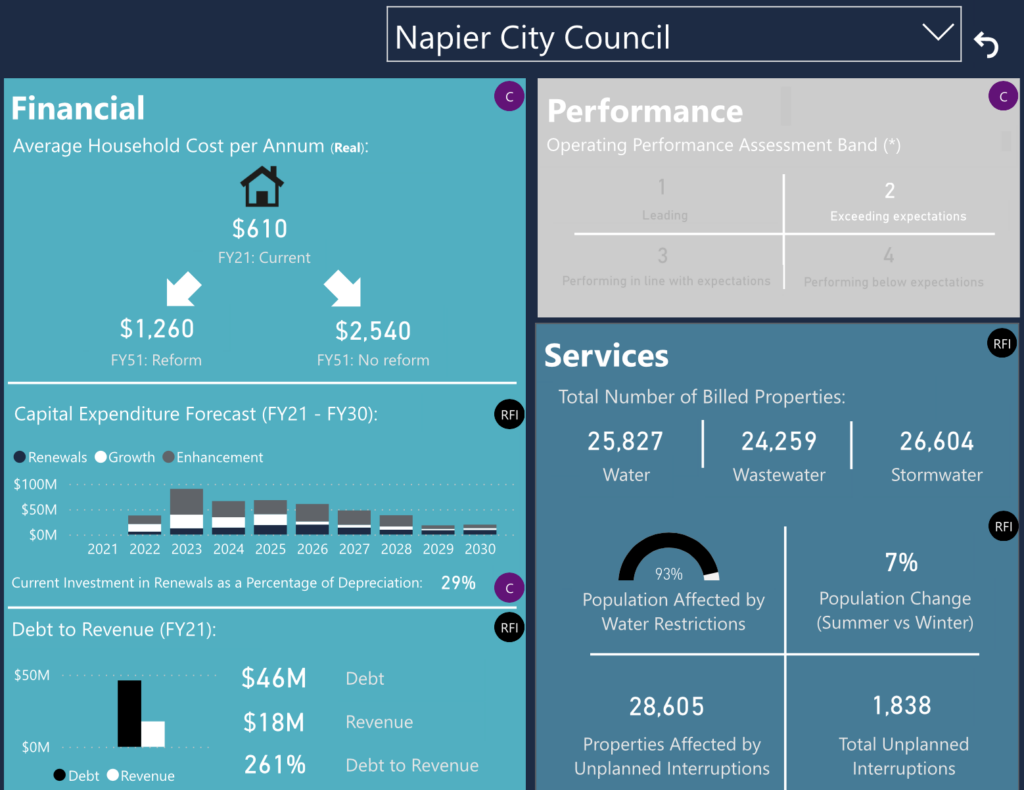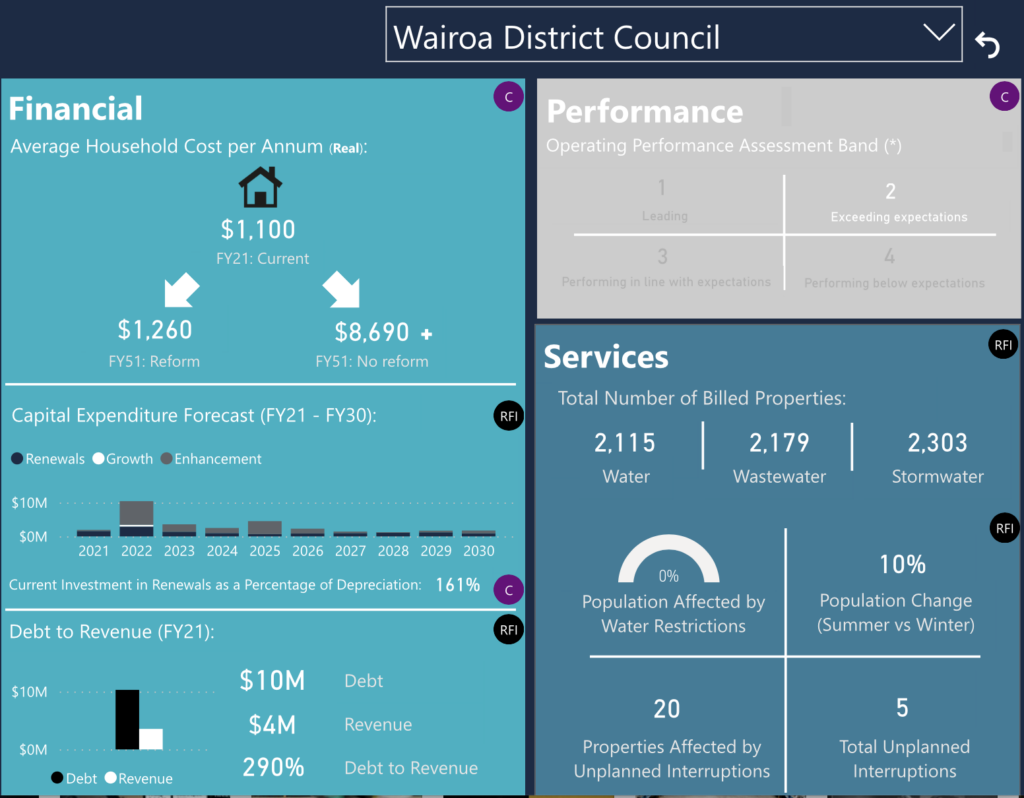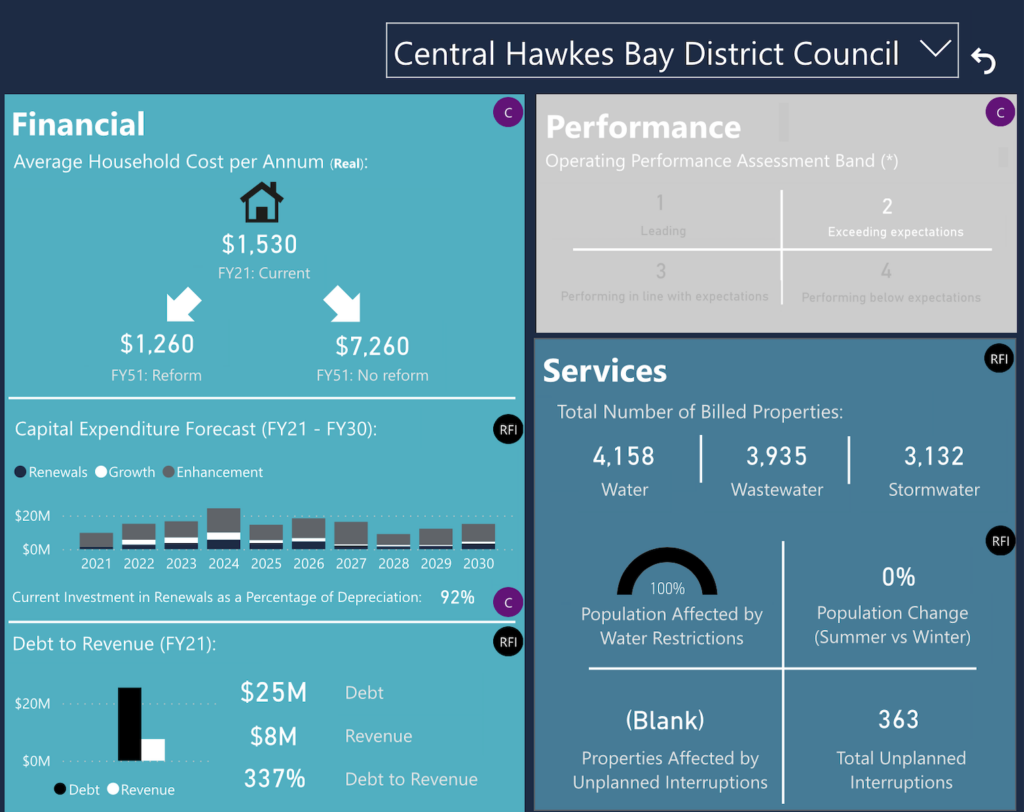The Government has made two blockbuster announcements this week. Both have huge significance for our region:
- Release of an ‘exposure draft’ of its planned Natural and Built Environments Act (NBA), which would replace the much-criticised Resource Management Act (RMA)
- Restructuring of authority nationwide for management of drinking water, wastewater and stormwater services (3 Waters).
Yesterday we outlined the major changes signalled by the NBA; today we address the 3 Waters reforms.
Today, territorial authorities employ 4,900 council staff to operate a water infrastructure with $54.6 billion in assets delivering drinking water, wastewater and stormwater services to 4.3 million customers, 85% of New Zealanders.
The system is badly broken.
The Government says*: “While there are pockets of good performance, in many parts of the country communities cannot be confident that their drinking water is safe, that the three waters sector is achieving good environmental outcomes, that it can accommodate population and housing growth, that the rights and interests of iwi/Māori are being upheld, and that climate change and natural hazard risks are being successfully managed.”
To those in the know, this comes as no surprise. The Auditor General back in 2017 reported that local authorities were not investing enough in three waters assets to the point they were deteriorating and unable to meet expected community service levels. In releasing its plans this week, the Government drew its own conclusion, based on information provided by local authorities, that “there has been systematic under-funding of economic depreciation by local authorities in New Zealand”.
How has this come about?
The Government says, rather charitably: “Local authority service providers operate in a political environment, in which investment decisions are made by elected representatives who have a duty to consider broader community interests (for example, other investment priorities and affordability of rates increases) and a constrained financial environment, in which the main funding and financing mechanisms are via ratepayers and council borrowing.”
And what’s the result?
One in five New Zealanders are supplied with drinking water that is not guaranteed to be safe from bacterial contamination, according to the Health Ministry. Don’t we know it?!
The Government observes: “Specific cases of water contamination in recent years have also dented public confidence in the system for delivering three waters services and exposed the systemic issues facing the sector. The Havelock North tragedy was the largest recorded outbreak of waterborne disease in the country, killing four people and causing illness in 5,500 of the town’s 14,000 residents.” Adding: “The economic cost of the Havelock North outbreak to the country was calculated to be $21 million.”
And no ‘public servant’ was held accountable!
Reform measures
Reform via consolidation of services is proposed as the only affordable path to providing modern, competent, safe, environmentally suitable water services.
With ancillary benefits like curbing simple leakage. It’s estimated that 21% of water supplied to networks is lost on the way to end use – more than the combined volume of water supplied by Christchurch City and Wellington Water. And it’s getting worse – the median annual real water loss per property has increased by 44% in the last five years. Not insignificant in a region like ours that struggles to allocate limited water amongst competing users.
Overseas advisors to the Government say that the cost of bringing NZ’s water infrastructure up to modern standard and meeting increasing demand will be in the $120b to $185b range over the next 30 years. Independent reviewer Beca says these figures are “conservative as these do not include certain factors unique to New Zealand such as giving effect to iwi/Māori aspirations and building seismic resilience.”
Advisors say international experience indicates service providers should be operating at the scale of 600,000 to 800,000 population served to capture available economies of scale.
And thus, says Government, affordability requires consolidation and these associated measures:
- Establish four statutory, publicly-owned water services entities to provide safe, reliable and efficient water services;
- Enable the water services entities to own and operate three waters infrastructure on behalf of local authorities, including transferring ownership of three waters assets and access to cost-effective borrowing from capital markets to make the required investments;
- Establish independent, competency-based boards to govern each water services entity;
- Set a clear national policy direction for the three waters sector, including expectations relating to the contribution by water services entities to any new spatial/resource management planning processes;
- Establish an economic regulation regime, to ensure efficient service delivery and to drive the achievement of efficiency gains, and consumer protection mechanisms;
- Develop an industry transformation strategy to support and enable the wider three waters industry to gear up for the new water services delivery system.
Governance
The crusher here to our local politicians is loss of direct control.
The four new entities will be governed by Independent Boards, “with the relevant competencies in delivering and managing three waters or similar network infrastructure and other appropriate skills”. An Independent Selection Panel will appoint Board members.

Each entity will have a Regional Representative Group that provides for representation of the local authority ‘owners’ of the entity and of mana whenua, with mana whenua and local authorities represented on a 50:50 basis. This Group will ‘inform’ its Independent Board through a Statement of Strategic and Performance Expectations and appoint members to the Selection Panel.
Thus: You > Elected councillors > Independent Selection Panel > Independent Board.
The Board will decide what to do, when, where, how much to charge, how much to borrow.
Ideally, in exchange for scale and ‘de-politicizing’ the process, we water consumers will get our core services significantly more cheaply and at better quality and health/environment safety. Estimated savings for Hawke’s Bay are shown in the infographics below.
But as the Government concedes: “There are no examples in New Zealand of an amalgamation of this scale and complexity.”
Local Government Minister Nanaia Mahuta has avoided giving a direct answer to queries regarding whether local councils will still have the choice of opting out of the reorganisation, as was previously signalled.
The plan is to introduce the Water Services Entities Bill late this year, with enactment by mid-2022. The Government’s goal is to have the four entities up and running no later than 1 July 2024.
Stay tapped in!
*All direct quotes from Government backgrounder: Transforming the system for
delivering three waters services. The case for change and summary of proposals.
June 2021






“
Enable the water services entities to own and operate three waters infrastructure on behalf of local authorities, including transferring ownership of three waters assets and access to cost-effective borrowing from capital markets to make the required investments”. A neat little package for another government to flog off ! Privatisation will insure you and I will end up with a BIG water while profits ‘stream’ to the ocean and land further off shore.
Privatisation would require referendum with 75% majority
Please provide the source of your reply ?
If you go to end of article, there are two links to Government docs, one the bill itself and one a detailed explanation. The anti-privatisation provisions are there.
It annoys me that this criticism of past councils overlooks the fact that communities could only upgrade their systems if they could afford to do so. For years, small towns like Waipukurau and Waipawa simply did not have the ability to rate for the 3W upgrades that are now being talked about and more importantly “the money” was not spent on so called vanity projects instead. I’ll bet that none of these boards will deliver either a better result or lower costs per ratepayer.